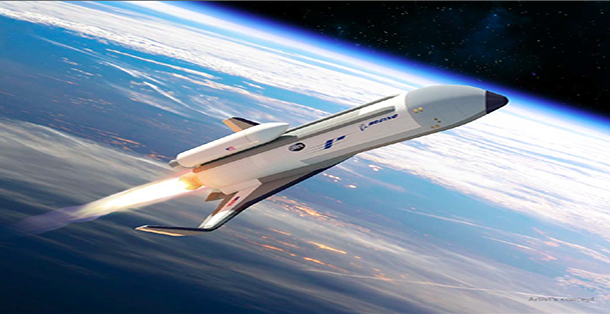
An artist rendering of the new XS-1 Spaceplane, which Boeing has dubbed the "Phatom Express," after its Phantom Works advanced projects organization. Photo courtesy of DARPA.
The Defense Advanced Research Projects Agency has chosen Boeing to be its collaborator in a public/private partnership to develop the Experimental Spaceplane, or XS-1.
The winning concept, which Boeing has dubbed “Phantom Express,” after its Phantom Works advanced projects organization, is a reusable winged launch vehicle that carries its payload with booster rocket piggyback at hypersonic speed to high altitude. After releasing the payload and booster to continue their journey to orbit, the XS-1 will return to Earth, landing on a runway like an airplane.
Fabrication will take place through 2019, with flight evaluations projected for 2020.
A DARPA press release said a mature version of the vehicle could “revolutionize the nation’s ability to recover from a catastrophic loss of military or commercial satellites, upon which the nation is critically dependent.”
Aimed at “short notice, low-cost access to space,” the project calls for operating the engines on the ground 10 times in 10 days, followed by 12-15 actual flight tests without a payload, at speeds up to Mach 5. All this would culminate in 10 actual suborbital missions flown in 10 days, with one further flight to loft and deploy a 3,000-pound satellite. The overall idea is to achieve an “aircraft-like” operations tempo.
Both DARPA and Boeing are investing money in the concept; DARPA’s share is about $146 million.
In a statement, Phantom Works president Darryl Davis said the vehicle “is designed to disrupt and transform the satellite launch process as we know it today, creating a new, on-demand space-launch capability that can be achieved more affordably and with less risk.”
Boeing selected Aerojet Rocketdyne to provide propulsion, which will be in the form of AR-22 engines assembled from leftover components of Space Shuttle Main Engines in the inventories of NASA and the company. The motors will be assembled and tested at NASA’s Stennis Space Center in Mississippi.
The XS-1 is described by DARPA as being “roughly the size of a business jet.” The vehicle would take off vertically, but without additional boosters; all cryogenic propellant would be carried in its center body. A cost of $5 million per launch—including the expendable satellite booster—is the target, although DARPA noted that this figure would be for actual cost, “not commercial price, which would be determined in part by market forces.”
To achieve an aircraft-like operations tempo, the craft will have “easily-accessible subsystem components configured as line-replaceable units,” DARPA said, to enable “quick maintenance and repairs.” Other already developed technologies that will be incorporated on the vehicle include lightweight composite cryogenic propellant tanks to hold liquid oxygen and hydrogen, “hybrid-composite metallic wings” able to withstand temperatures exceeding 2,000 degrees Fahrenheit, and autonomy technologies derived from DARPA’s Airborne Launch Assist Space Access program.
One goal of the program is to “encourage the broader commercial launch sector to adopt useful XS-1 approaches, processes, and technologies that facilitate launch on demand and rapid turnaround—important military and commercial needs for the 21st century,” DARPA said. The agency said it would “release selected data” from the project “and will provide to all interested commercial entities the relevant specs for potential payloads.”
The XS-1 is the latest in a long line of US military attempts at achieving aircraft-like space launch capability. During the 1980s, a number of agencies jointly pursued the X-30 National Aerospace Plane (NASP) project, touted by President Ronald Reagan as someday enabling flights between New York and Tokyo in two hours. The Lockheed X-33 VentureStar, in the 1990s, was the next attempt, expected to succeed the Space Shuttle, but both it and the NASP were terminated because the needed technologies were not yet in hand. DARPA’s Responsive Access, Small Cargo Affordable Launch, or RSCAL program, was its latest try, in the early 2000s, aimed at putting a 300-pound payload into orbit for under $750,000.
Teams led by Northrop Grumman and Masten Space Systems participated in phase 1 of the XS-1.
Boeing is also the prime contractor for the Air Force’s X-37B miniature spaceplane, one of which recently returned to Earth after more than two years in space.